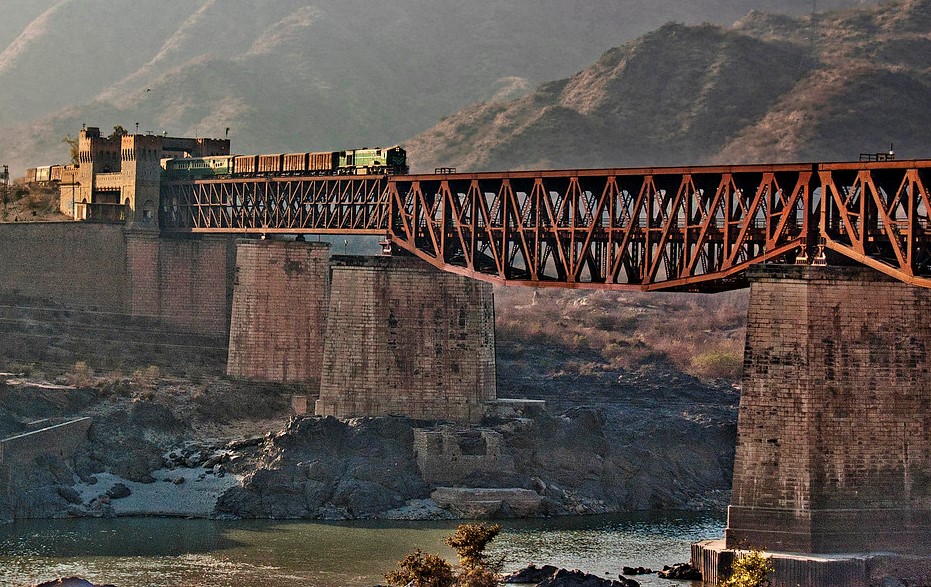The word Attock in Urdu, Punjabi, Pothohari and Hindko languages means to get stuck. Justifying Attock’s name by saying that the flow of the river gets blocked at this point, then it will be wrong because at this point the river bed is large than in the north. And it is so big that it also hugs Abaseen at this point.
If the word Attock is pronounced, it can mean calm, stay or stop. Apparently, the river becomes calm at this point and due to the narrowing of the river bed at the Ghora Tarp point in the south, the speed of the water increases once again.
The other reason for the name Attcok may be the caravans coming from Central Asia because they would get stuck here after a long journey or would come here and get stuck until they found a boat. Another Urdu word similar to Attock is Phattik. (A knot or a snare) Phattik is associated with some prohibition, temporary or permanent, but the function of obstruction or entrapment is taken only.
Another tradition written by Muhammad Hotak in the historical book Patta Khazana is that upon the arrival of the Arya Samaj, they banned crossing the river, that is why the name Attock came into being.
Sir Olaf Caroe has mentioned in his book “The Pathans” that the Ratan Hindu Raja Mahesh Das, also known as Birbal, of Akbar built a fort here in 1581 AD. And that when Akbar arrived to inspect the foundations of the Attock Fort, Qasim Khan had a bridge of boats built here.
Attock District is located at 33.894 degrees north, 72.241 degrees east. Attock is a city in the Punjab province and the headquarters of Attock District. It was given the status of a district in 1940. There are six tehsils of Attock District. The full name Attock city is written and spoken because a town called Attock Khurd is located on the banks of the Indus River. Attock Fort Benares is also located there. The present city of Attock was previously named Campbellpur, which was settled by the British government as a cantonment.
Later, this name was changed again to Attock city. The following tehsils are in Attock district. Tehsil Attock Tehsil Hassan Abdal Tehsil Fateh Jang Tehsil Jund-Tehsil Hazro Tehsil Pindibheb Important areas of Attock district include Hassanabdal, Wadi Chhich and Fateh Jang Tehsil Pindibheb Attock is a historical place. Emperor Akbar had a fort built here, which is known as Attock Benares Fort, which can still be seen. Gurdwara Panja Sahib, a place of worship for the Sikh religion, is located in Hassanabdal.
In the 1998 census, the population of Attock was more than 12 lakh 78 thousand.
According to the 2017 census, it consisted of 18 lakh 83 thousand 556 people. Its area is 2648 square miles. The height above sea level is 2758 feet.
“Historical, geographical and recreational place”
The Indus River (which is called Abaseen in Pashto, meaning the father of rivers) and is located at the confluence of the beautiful Kabul River and both rivers run side by side for quite a long time and their water does not merge with each other and both rivers can be seen from afar due to their different water colors.
This is the historical place where in 326 BC Alexander the Great crossed the Indus River from this place and conquered most of India.
The biggest battle in the history of Hindus and Muslims took place at this place between Raja Anand Pal, son of Raja Jaypal, and Mahmud Ghaznavi. It was fought in the last days of 1008, in which Anand Pal was defeated.
At this place, Jalaluddin Khwarazm Shah fought the Battle of Indus between the Mongols (Genghis Khan) on 24 November 1221. After being defeated by the Mongols, Khwarazm Shah jumped into the river along with his horse and reached the other side safely, while the Mongols could not cross the river.
At this place, Amir Taimoor invaded India on 30 September 1398 from Samarkand.
Emperor Akbar built a fort at this place in the 16th century AD, which still stands in full glory today.
At this place, a battle was fought between Ahmad Shah Durrani and the Marathas on 28 April 1758.
This place connects the provinces of Punjab and Khyber Pakhtunkhwa, and it has been and is an international highway since ancient times.
In view of the geographical importance of this place, the British established a very beautiful railway station in 1884, which is still the most beautiful railway station in Pakistan.
Right next to the railway station, a beautiful double-decker (train track on top and road for buses etc. on the bottom) bridge was built by the British company White Westing House.
The government of Pakistan has started a safari train from Golra Railway Station, Islamabad to Attock Khurd Railway Station, which runs every Sunday.
There is also a beautiful island (Bhari Island) at the same place. There is a beautiful lake with Bhari Island where camping and fishing can be done. Jeep safari is done on the sands of Bhari Island.
Outside Attock Fort, Bahram’s twelve gates.
Begum’s Sarai.
Attock Tomb etc. are historical buildings.
There is also a Sikh Gurdwara with Attock Fort.
The English writer A. J. Toynbee wrote an article about this place called “The Indus in fetters” and this article is being taught in the fourth year English of the University of Peshawar.
Attock has its own history and cultural customs. Its famous dish is Katwa Gosht and Makhandi Halwa. Among the cultural games here, spear throwing has a separate identity all over the world. And the owner of spear throwing and his dignified personality, Malik Atta Muhammad Khan, has his own identity all over the world. In short, this area is second to none in its history and culture.





